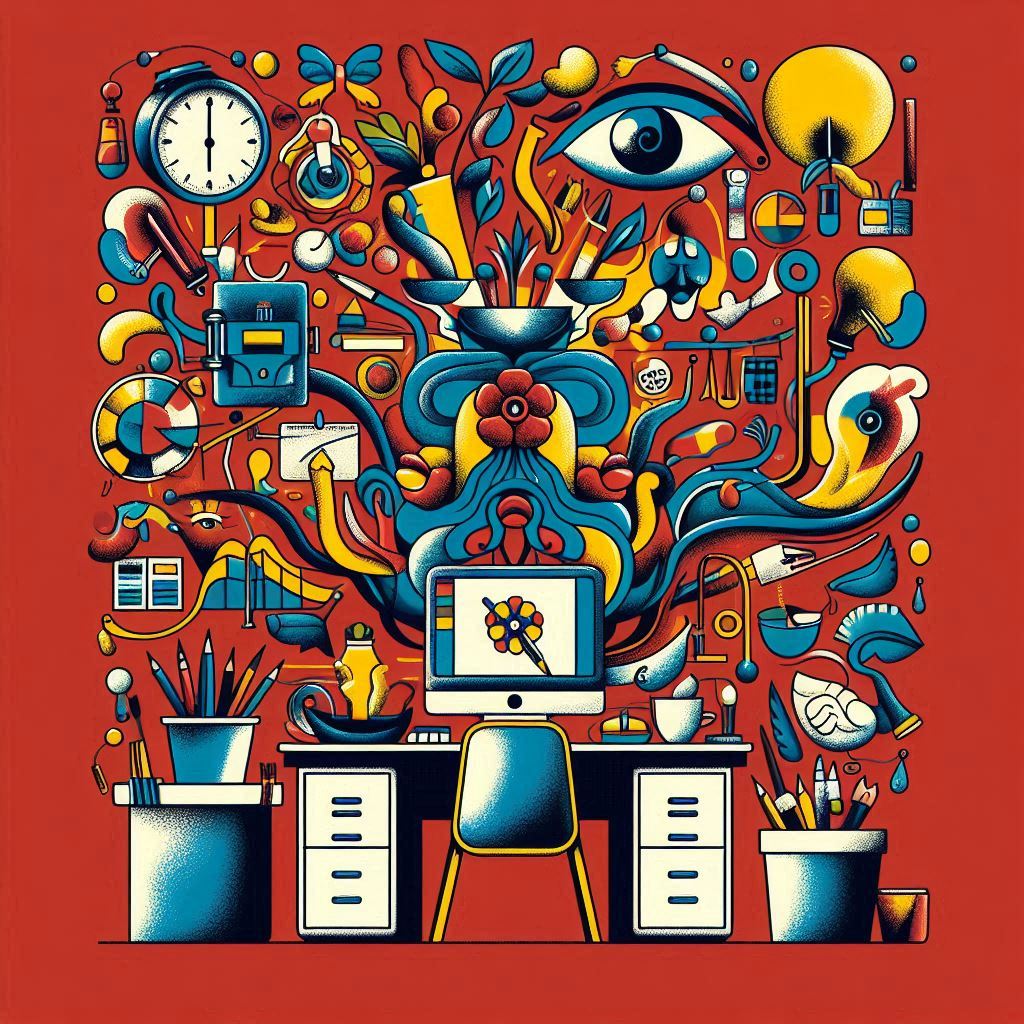Creative Examples in Business Explained
Big or small businesses always seek ways to stay ahead in the competitive market. Creativity is a key factor in achieving this. Unique marketing strategies and innovative product designs are just a few examples of how creativity influences business success.
This article will explore creative business examples and how they positively impact companies. Clever advertising campaigns and fresh customer service approaches demonstrate the power of creativity in driving business success.
The Significance of Creativity in Business
How Creativity Fuels Innovation and Growth
Creativity drives business innovation and growth by generating new ideas, approaches, and solutions.
For instance, innovative marketing strategies like unconventional advertising and unique branding can inspire customer perception and create a competitive edge.
Moreover, creative leadership fosters innovative thinking throughout the organization, increasing employee loyalty and value in the workplace.
Creativity enhances organizational productivity by enabling employees to think outside the box and develop more efficient processes.
Adaptability relies on creative thinking to drive innovation and growth, as innovation only happens when change occurs.
Encouraging employees to cultivate and implement new ideas allows organizations to stay ahead of industry trends and sustain long-term success.
The Role of Creativity in Boosting Productivity
Creativity helps boost productivity in the workplace. It encourages innovative thinking and unique solutions to business challenges. When employees think outside the box, they find more efficient ways to approach tasks. Creative thinking sparks innovation and growth by inspiring new product ideas, marketing strategies, and problem-solving methods. Companies that promote a culture of creativity are more likely to stay ahead and adapt to market demands.
Adaptability relies on creative thinking and problem-solving to meet new challenges and capitalize on opportunities. Embracing creativity helps companies gain a competitive edge and sustain success in today’s business environment.
Why Adaptability Requires Creative Thinking
Adaptability and creative thinking go hand in hand in the workplace. Adaptability helps individuals or organizations think creatively when dealing with changing circumstances and demands.
For example, innovative marketing strategies can give a competitive edge and influence customer perception. Individuals are better prepared to adapt to new challenges and opportunities when encouraged to approach projects creatively.
Moreover, emphasizing creativity in leadership and project management allows organizations to foster a progressive thinking and problem-solving environment. This helps in developing innovative solutions for adapting to new challenges and opportunities.
Creativity as a Sought-after Skill in the Workforce
Creativity in business shows up in different ways. It could be in leadership, marketing, problem-solving, sales, project management, and production.
For example, letting employees share their unique ideas when working on projects encourages creativity and leads to change, which drives innovation and growth in business.
Also, having a diverse team brings new perspectives, boosts creativity while promoting creativity in leadership, and sparks innovative thinking across the organization.
Using creative marketing techniques can shape how customers see the business and create a competitive edge, adapting to change through creative thinking at work. Being able to adapt is essential for a business to keep succeeding.
Creativity is a highly desired skill in the workforce, especially when paired with the ability to use innovation strategies and keep up with industry trends for long-term success.
Encouraging Creative Leadership: Benefits and Strategies

Fostering Creative Problem Solving among Leaders
Leaders can think creatively when solving problems by fostering creative freedom. This allows them to showcase innovative approaches and unique perspectives. Building a diverse team can lead to unique conversations and enhance problem-solving. Strategies to foster a creative problem-solving culture include facilitating change and encouraging new ideas. Leaders promoting innovative thinking can inspire increased employee loyalty and value.
Creative marketing strategies can influence customer perception and create a competitive edge. Creative problem-solving among leaders can impact the organization’s overall success and innovation. Attention to industry trends and effective innovation strategies are essential for business success.
The Impact of Creative Leaders on Organizational Culture
Creative leaders have a big impact on an organization’s culture. They encourage thinking outside the box, leading to a workplace that values innovation, open-mindedness, and adaptability. They do this by allowing creative freedom, building a diverse team, facilitating change, promoting creativity in leadership, and using innovative marketing. These strategies help support creative leadership and positively impact the organizational culture.
For instance, allowing creative freedom allows employees to showcase their unique approaches. Building a diverse team enhances creativity while facilitating change and encouraging the development and implementation of new ideas. Encouraging creativity in leadership promotes innovative thinking, and using creative marketing inspires customer perception and creates a competitive edge. Lastly, paying attention to industry trends and using an effective innovation strategy is crucial for business success.
Creativity in Marketing: A Must for Business Success

Leveraging Creative Campaigns to Engage Consumers
There are effective strategies for leveraging creative campaigns. These include:
- Allowing for creative freedom
- Building a diverse team
- Facilitating change
- Encouraging creativity in leadership
- Using creative marketing
Businesses can stay ahead by paying attention to trends and implementing an effective innovation strategy. Creativity is crucial for successful marketing and engaging consumers. It inspires innovative thinking, enhances customer perception, and creates a competitive edge.
Staying Ahead of Trends through Innovative Marketing
Innovative marketing strategies are essential for businesses to stay ahead of evolving trends. Businesses can use unique approaches to capture consumer attention and stand out in a crowded marketplace.
For instance, creative branding, interactive content, and unique visual elements can help a company differentiate itself and remain relevant to consumers.
Also, integrating creativity and design thinking into business analytics allows for more informed decision-making in marketing strategies. By analyzing consumer behavior, market trends, and competitive landscapes through a creative lens, businesses can create more effective and engaging marketing campaigns.
Sales and Creativity: An Unbeatable Combination

Creative Sales Strategies that Yield Results
Creative sales strategies often involve innovative thinking and unique approaches. For instance, some organizations have successfully used creative marketing techniques to inspire customer perception and gain a competitive edge.
Fostering a diverse team within the sales department can lead to unique conversations and enhance the creativity process, ultimately improving customer engagement.
Furthermore, encouraging creativity in leadership can promote innovative thinking throughout the organization, increasing employee loyalty and value in the workplace.
Innovative thinking is critical in developing effective sales strategies that drive tangible results. This allows organizations to stay ahead of industry trends and stand out in the business world.
Building Personal Connections through Creative Sales Techniques
Sales techniques can build personal connections with customers by tailoring sales approaches to meet individual customer needs, preferences, and interests. For example:
- Incorporating personalized and interactive sales presentations
- Implementing customized product solutions
- Actively listening to customer feedback
These techniques contribute to long-term customer loyalty and satisfaction by fostering trust, understanding, and a sense of personal investment in the client’s success. Additionally, integrating creativity into the sales process allows for the development of innovative sales strategies, which can set a business apart from its competitors and enhance the overall customer experience.
Project Management Revitalized by Creative Approaches

How Creative Project Management Leads to Better Outcomes
Creative project management helps businesses by encouraging unique problem-solving and out-of-the-box thinking. This fosters a culture of innovation and allows employees to showcase their creativity. Building a diverse team with varied backgrounds enhances the creativity process. Creativity in leadership promotes innovative thinking, increasing employee loyalty.
Creative marketing strategies inspire customer perception and create a competitive edge, leading to higher customer engagement and brand loyalty. Leveraging creative approaches in project management drives better results through increased innovation, productivity, and customer engagement, ultimately leading to sustained business success.
Diverse Teams as a Crucible for Creative Thinking
Diverse teams bring together individuals with different backgrounds, perspectives, and experiences. This leads to many ideas and solutions, sparking creativity and innovative thinking.
The varied viewpoints in a diverse team challenge assumptions, resulting in unique approaches to problem-solving and fostering an environment where creativity flourishes.
The benefits of having a diverse team include increased adaptability, improved decision-making, and a broader range of insights.
Strategies to harness the creative potential of diverse teams include promoting open communication, embracing diverse perspectives, and creating an inclusive environment where all team members feel valued and heard.
Fostering a culture that encourages risk-taking and experimentation can further enhance the creative potential of diverse teams, ultimately leading to innovative solutions and a competitive edge in the business world.
Driving Workplace Creativity: Policies and Environments That Work

The Importance of Creative Freedom in the Workplace
Creative freedom in the workplace is important. It lets employees show their unique ideas and boosts innovation and growth. When employees can try new ideas, they are more likely to create new products and processes that move the company forward.
Creative thinking is essential. It helps boost productivity and adaptability by encouraging employees to think differently and find new solutions. When employees are told to think creatively, they can easily adapt to change and solve challenges, making the organization more adaptable and productive.
Encouraging Intrapreneurship: Cultivating an Innovative Internal Climate
Organizations can promote intrapreneurship by:
- Allowing for creative freedom
- Building a diverse team
- Facilitating change
- Encouraging creativity in leadership
- Using creative marketing
These strategies foster a culture of innovative thinking and problem-solving. This, in turn, leads to greater interpersonal connection, higher loyalty, productivity, and innovation. Prioritizing creativity and intrapreneurship as part of the organizational culture is crucial for staying ahead of industry trends and sustaining success in today’s business environment.
Interpersonal Dynamics and Creative Conflict Resolution

Using Empathy to Navigate and Resolve Conflicts Creatively
In the workplace, using empathy can help navigate and resolve conflicts.
By actively listening to team members’ concerns and acknowledging their feelings, individuals can understand the root causes of conflicts.
Embracing innovative approaches that incorporate empathy can address interpersonal issues and conflicts. This can be achieved through mediation sessions, team-building activities, and open communication to foster understanding.
These conflict-resolution techniques can enhance teamwork and collaboration within an organization. This creates a safe and inclusive environment where employees feel valued and supported, resulting in higher loyalty, productivity, and a more positive workplace atmosphere.
Innovative Solutions to Common Interpersonal Issues
Innovative solutions to common workplace issues can include:
- Allowing for creative freedom to showcase unique approaches.
- Building diverse teams to enhance the creativity process.
- Facilitating change to cultivate and implement new ideas.
Creative and design thinking can address and solve conflicts within a team or organization. This involves encouraging change and promoting innovative thinking throughout the organization.
Empathy and understanding can also be leveraged to navigate and resolve conflicts creatively in an interpersonal context. This can lead to greater interpersonal connection, higher loyalty, productivity, and innovation in the workplace.
These creative, interpersonally sensitive practices can help an organization foster a creative culture, promote industry trends, and adopt an effective innovation strategy for sustained business success.
Design Thinking as a Gateway to Organizational Creativity

Bridging Operational Efficiency with Innovative Design
Design thinking can help organizations improve their processes and develop innovative designs. It involves using cross-functional teams, brainstorming, and prototyping to solve complex problems. This can lead to more efficient processes and creative designs. Strategies like data visualization and predictive modeling can also help integrate creativity with business analytics for better decision-making.
Diverse teams promote creative thinking and innovation by bringing together people with different perspectives and expertise. This encourages unique ideas and fosters a culture of innovative thinking, ultimately bridging operational efficiency with creative design.
Integrating Creativity with Business Analytics for Enhanced Decision Making
Integrating creativity with business analytics can fuel innovation and growth in decision-making. It encourages out-of-the-box thinking and new approaches to problem-solving.
Fostering a creative culture in the workplace can lead to a more innovative and unique approach to analytics, resulting in fresh perspectives and solutions.
Organizations can benefit from strategies such as allowing creative freedom, building diverse teams, and facilitating change to foster creative problem-solving and leadership.
Implementing these strategies can enhance businesses’ decision-making processes by ensuring they have a variety of viewpoints and innovative ideas to draw from.
Integrating creativity with business analytics can also lead to more effective decision-making through strategies such as encouraging creative marketing and paying attention to industry trends.
This holistic approach gives companies a competitive edge and inspires a fresh customer perception, ultimately leading to sustained business success.

Vizologi is a revolutionary AI-generated business strategy tool that offers its users access to advanced features to create and refine start-up ideas quickly.
It generates limitless business ideas, gains insights on markets and competitors, and automates business plan creation.


